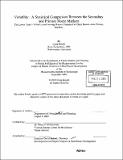| dc.contributor.advisor | Henry O. Pollakowski. | en_US |
| dc.contributor.author | Knight, Craig, 1971- | en_US |
| dc.contributor.other | Massachusetts Institute of Technology. Dept. of Urban Studies and Planning. | en_US |
| dc.coverage.spatial | n-us-ma | en_US |
| dc.date.accessioned | 2006-03-24T16:23:23Z | |
| dc.date.available | 2006-03-24T16:23:23Z | |
| dc.date.copyright | 2003 | en_US |
| dc.date.issued | 2003 | en_US |
| dc.identifier.uri | http://hdl.handle.net/1721.1/29764 | |
| dc.description | Thesis (S.M.)--Massachusetts Institute of Technology, Dept. of Urban Studies and Planning, 2003. | en_US |
| dc.description | Includes bibliographical references (leaves 51-52). | en_US |
| dc.description.abstract | This thesis attempts to analyze the long-standing perception that the secondary home market, homes built in and around vacation areas, is more volatile than the primary home market. For the first time, this study measures the volatility of a secondary home market, the Lower Cape. This markets volatility and average return are then compared with three primary housing markets in Boston's Metropolitan Statistical Area. In order to compare the volatilities and average returns among the markets, a price index for Lower Cape Cod was estimated by applying the repeat sales regression technique to sales transaction data from the Warren Group. The Case, Shiller, Weiss zip code price indexes for the Boston area were used for the comparison primary markets. The results from the study suggest that the secondary market is not more volatile than all primary markets. In fact, from these findings it appears that secondary markets have very similar volatilities and average returns to primary markets within 10 miles of the economic center of the region. This study finds that the Lower Cape was less volatile and had lower average returns than the market region within five miles of downtown Boston. The study also demonstrates that the Lower Cape's housing market is highly correlated with Boston's market and appears to lag behind Boston's market by one year. | en_US |
| dc.description.statementofresponsibility | by Craig Knight. | en_US |
| dc.format.extent | 52 leaves | en_US |
| dc.format.extent | 2035886 bytes | |
| dc.format.extent | 2035695 bytes | |
| dc.format.mimetype | application/pdf | |
| dc.format.mimetype | application/pdf | |
| dc.language.iso | eng | en_US |
| dc.publisher | Massachusetts Institute of Technology | en_US |
| dc.rights | M.I.T. theses are protected by copyright. They may be viewed from this source for any purpose, but reproduction or distribution in any format is prohibited without written permission. See provided URL for inquiries about permission. | en_US |
| dc.rights.uri | http://dspace.mit.edu/handle/1721.1/7582 | |
| dc.subject | Urban Studies and Planning. | en_US |
| dc.title | Volatility-- a statistical comparison between the secondary and primary home markets : the lower Cape's volatility and average return compared to three Boston area primary markets | en_US |
| dc.title.alternative | Statistical comparison between the secondary and primary home markets : the lower Cape's volatility and average return compared to three Boston area primary markets | en_US |
| dc.title.alternative | Lower Cape's volatility and average return compared to three Boston area primary markets | en_US |
| dc.type | Thesis | en_US |
| dc.description.degree | S.M. | en_US |
| dc.contributor.department | Massachusetts Institute of Technology. Department of Urban Studies and Planning | |
| dc.identifier.oclc | 54699531 | en_US |
